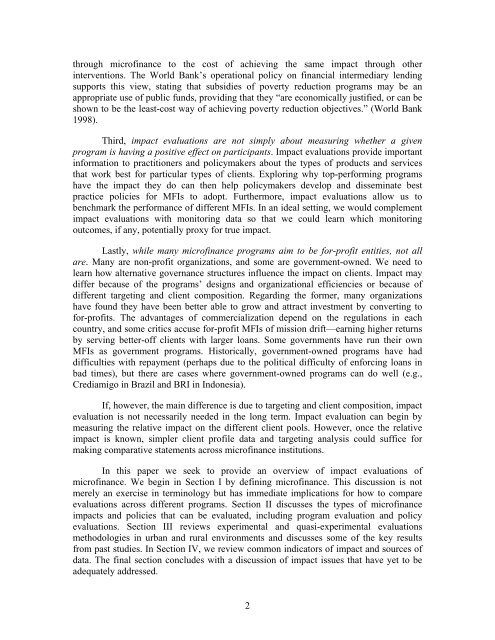Impact Evaluation for Microfinance: Review of Methodological Issues
Impact Evaluation for Microfinance: Review of Methodological Issues
Impact Evaluation for Microfinance: Review of Methodological Issues
You also want an ePaper? Increase the reach of your titles
YUMPU automatically turns print PDFs into web optimized ePapers that Google loves.
through micr<strong>of</strong>inance to the cost <strong>of</strong> achieving the same impact through other<br />
interventions. The World Bank’s operational policy on financial intermediary lending<br />
supports this view, stating that subsidies <strong>of</strong> poverty reduction programs may be an<br />
appropriate use <strong>of</strong> public funds, providing that they “are economically justified, or can be<br />
shown to be the least-cost way <strong>of</strong> achieving poverty reduction objectives.” (World Bank<br />
1998).<br />
Third, impact evaluations are not simply about measuring whether a given<br />
program is having a positive effect on participants. <strong>Impact</strong> evaluations provide important<br />
in<strong>for</strong>mation to practitioners and policymakers about the types <strong>of</strong> products and services<br />
that work best <strong>for</strong> particular types <strong>of</strong> clients. Exploring why top-per<strong>for</strong>ming programs<br />
have the impact they do can then help policymakers develop and disseminate best<br />
practice policies <strong>for</strong> MFIs to adopt. Furthermore, impact evaluations allow us to<br />
benchmark the per<strong>for</strong>mance <strong>of</strong> different MFIs. In an ideal setting, we would complement<br />
impact evaluations with monitoring data so that we could learn which monitoring<br />
outcomes, if any, potentially proxy <strong>for</strong> true impact.<br />
Lastly, while many micr<strong>of</strong>inance programs aim to be <strong>for</strong>-pr<strong>of</strong>it entities, not all<br />
are. Many are non-pr<strong>of</strong>it organizations, and some are government-owned. We need to<br />
learn how alternative governance structures influence the impact on clients. <strong>Impact</strong> may<br />
differ because <strong>of</strong> the programs’ designs and organizational efficiencies or because <strong>of</strong><br />
different targeting and client composition. Regarding the <strong>for</strong>mer, many organizations<br />
have found they have been better able to grow and attract investment by converting to<br />
<strong>for</strong>-pr<strong>of</strong>its. The advantages <strong>of</strong> commercialization depend on the regulations in each<br />
country, and some critics accuse <strong>for</strong>-pr<strong>of</strong>it MFIs <strong>of</strong> mission drift—earning higher returns<br />
by serving better-<strong>of</strong>f clients with larger loans. Some governments have run their own<br />
MFIs as government programs. Historically, government-owned programs have had<br />
difficulties with repayment (perhaps due to the political difficulty <strong>of</strong> en<strong>for</strong>cing loans in<br />
bad times), but there are cases where government-owned programs can do well (e.g.,<br />
Crediamigo in Brazil and BRI in Indonesia).<br />
If, however, the main difference is due to targeting and client composition, impact<br />
evaluation is not necessarily needed in the long term. <strong>Impact</strong> evaluation can begin by<br />
measuring the relative impact on the different client pools. However, once the relative<br />
impact is known, simpler client pr<strong>of</strong>ile data and targeting analysis could suffice <strong>for</strong><br />
making comparative statements across micr<strong>of</strong>inance institutions.<br />
In this paper we seek to provide an overview <strong>of</strong> impact evaluations <strong>of</strong><br />
micr<strong>of</strong>inance. We begin in Section I by defining micr<strong>of</strong>inance. This discussion is not<br />
merely an exercise in terminology but has immediate implications <strong>for</strong> how to compare<br />
evaluations across different programs. Section II discusses the types <strong>of</strong> micr<strong>of</strong>inance<br />
impacts and policies that can be evaluated, including program evaluation and policy<br />
evaluations. Section III reviews experimental and quasi-experimental evaluations<br />
methodologies in urban and rural environments and discusses some <strong>of</strong> the key results<br />
from past studies. In Section IV, we review common indicators <strong>of</strong> impact and sources <strong>of</strong><br />
data. The final section concludes with a discussion <strong>of</strong> impact issues that have yet to be<br />
adequately addressed.<br />
2






